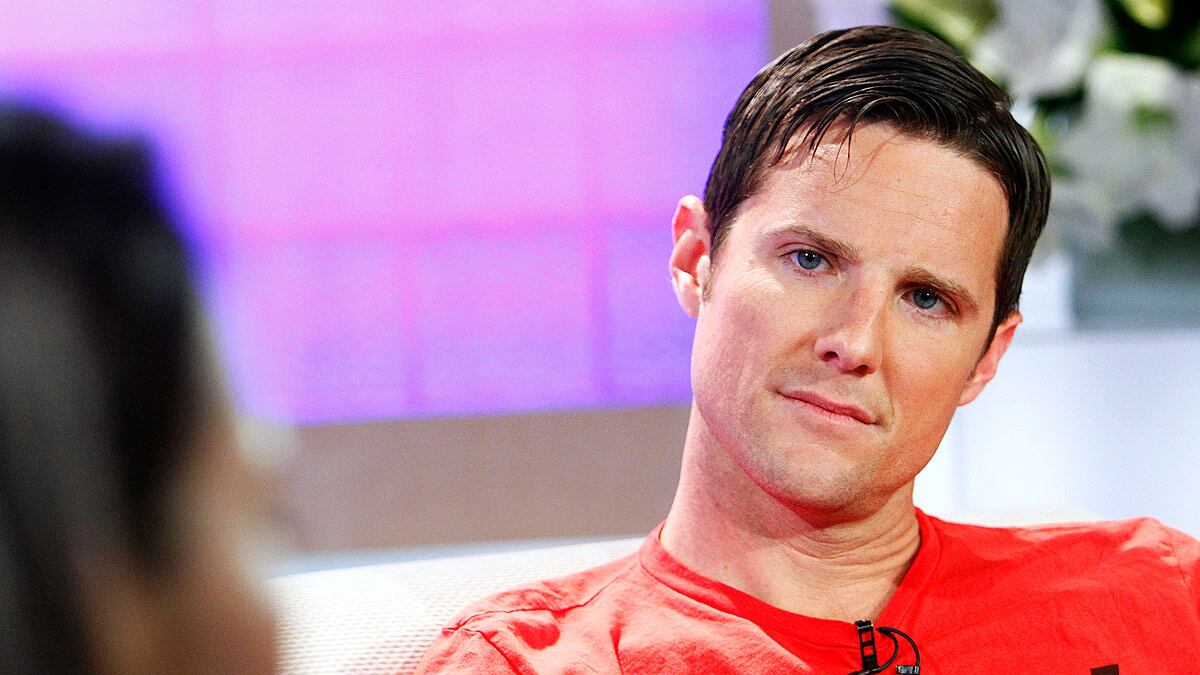Over the past six months, nearly 1.8 million people have watched a blurry YouTube video of a guy parading up and down a sidewalk in sunny San Diego, stark naked, acting stark-raving mad. It wasn’t the hot bod that drew people in, but the guy to whom it belonged: Jason Russell, of overnight Internet fame, the founder of a nonprofit dedicated to saving African children from Ugandan warlord Joseph Kony.
Russell’s rapid descent from admired creator of the glossy documentary Kony 2012 (itself viewed by more than 70 million people in less than a week) to cyberspace punching bag was a TMZ dream, and it provided ample material for comedians and Twitter alike. Russell, smartly, kept his mouth shut, and disappeared into treatment.
On Sunday, he’ll speak publicly (and clothed) for the first time since he lost it. He is collected and poised and bright-eyed in a pre-taped interview with Oprah Winfrey, just like he was in Kony 2012. The video led to all sorts of questions about Invisible Children, Russell’s nonprofit. Namely, what was it doing with the millions of dollars in revenue it collects via donations every year? The charity declined to comment for this story, but on its website, it says spending goes toward programs to find Kony, to raise awareness via films and to help children of war-torn areas rebuild their lives.
In clips provided to The Daily Beast by the show, Oprah’s Next Chapter, Oprah focuses more on the salacious topic at hand—Russell’s sidewalk-banging meltdown—than on his charity (to which Oprah herself reportedly gave $2 million). “What do you remember, Jason?” she asks him at one point.
“I remember me flipping off cars,” Russell says, as if he’s telling a story he himself can hardly believe.
Oprah seems bewildered by this. She must have seen the actual clip, recorded by a bystander that day in March, that shows Russell not just flipping off cars but screaming obscenities, prancing from one side of the busy street corner to the other, banging on the sidewalk. Still, she seems shocked.
“Flipping off cars,” she repeats. “Like with your...”
“With both hands. I remember that just like ‘doot,’ just like a little memory. I remember running around our lemon tree.”
Oprah then wants to know not just what Russell remembers, but how it happened: “How did you get your robe off? How do you go from running out with your robe on to your robe off?” she asks.
“Again, it, really it’s hard to explain if people have never had an out of body experience, but it really wasn’t me,” he says. “That wasn’t me, that person on the street corner ranting and raving and naked is not me. That’s not who I am.”
Russell was diagnosed not long after his meltdown with “reactive psychosis,” which is a form of temporary insanity. That happened, viewers of the Oprah Winfrey Network will see Russell explain on Sunday, because the magnitude of success and criticism that came with millions of viewers in a single week overwhelmed him. The first million clicks came in a single day.
“Within that 24 hours, we had hit a million, and we were—we popped champagne and went, a million views. This is so exciting. It’s the only time we’ve ever celebrated. And from that moment on, instead of just riding the wave on your surfboard excited?” Russell prompts.

“Yes,” Oprah replies.
“Tsunami.”
“Tsunami,” the host repeats.
Russell says it again. “Total tsunami. And you could feel it in your bones. The energy, everyone in Invisible Children, everyone felt it. It was like, what have we done?”
What they did was expose Invisible Children to a wide pendulum of public reaction, swinging wildly from the adulation of Bill Gates and Justin Bieber to the scathing criticism of people who accused Russell and his flock of dangerously oversimplifying a complicated geopolitical issue, and of raking in millions of dollars in donations without being accountable and transparent enough about how the money was spent. The hangover from that party was fierce, and it basically drove Russell nuts.
But it didn’t really slow down the cause, at least not much. Supporters leapt to Invisible Children’s defense and the charity beefed up the “financials” section of its web site, which leads with an eye-catching graphic that seeks to refute the leading criticism about how the charity spends its money: that only a third of the $13 million collected in the 2010-2011 fiscal year was actually spent in Uganda.
On its site, Invisible Children says 80.6 percent of its earnings goes “toward our programs,” including money spent in Africa, plus the “mobilization” of “massive groups of people to support and advance international efforts to end LRA atrocities” along with the making of documentaries like Kony 2012 to raise awareness.
Invisible Children released a sequel a month later, that sought to address its critics directly, to not only explain where it spends its money but to do a better job of making the case that finding Joseph Kony and hunting him down is still worthwhile, though Kony hasn’t been in Northern Uganda for years. That video, “Kony 2012: Part II—Beyond Famous,” has drawn roughly 2.4 million viewers on YouTube, a relative dud compared to the first one.
The Web site Charity Navigator gives Invisible Children a rating of two out of four stars in the “accountability and transparency” category, and GuideStar hasn’t given it a “GuideStar Exchange Seal,” which is one of the ways that non-profit watcher holds organizations accountable. Reviewers on the site give Invisible Children three of five stars, with some saying they donated money expecting an “action kit” in the mail that never arrived and others saying they weren’t able to cancel recurring payments.
Despite the criticisms, the campaign has had some success. In March, Congress passed a joint resolution condemning Kony. The African Union sent 5,000 troops into the jungle in search of the warlord, and President Obama deployed 100 U.S. military advisors to central Africa to help. In August, U.S. Secretary of State Hillary Clinton said she hoped drones would soon be able to penetrate the thick jungle cover that Kony uses for protection.
By some estimates, Invisible children took in three times as much money in the fiscal year that ended in June. The charity hasn’t posted its federal tax documents yet, so it’s impossible to confirm those numbers. But after the most viral video campaign of all time, that doesn’t seem like a tall guess.
“The groups that are best able to market and promote themselves aren’t necessarily the groups doing the most effective work, or operating the most effectively,” said Daniel Borochoff, president of CharityWatch, in an interview with The Daily Beast.
Next year, Invisible Children is planning a “global dance party” to keep awareness about Kony alive. But what about that warlord?
“Everybody gets frustrated: ‘Why can’t you just get him?’ “ said an aide to Sen. James Inhofe, R-Okla., in an interview. “It’s Africa. This area is immense. It is not easy.”
But the effort continues, the coordination among countries seeking to find Kony unprecedented, the staffer said. Invisible Children can take much of the credit for applying enough pressure on lawmakers to get their acts in gear.
“They have done an outstanding job of letting the rest of the world know who Kony is,” the aide said. “They were the ones that made Kony a household name.”





